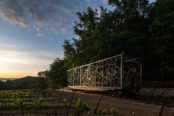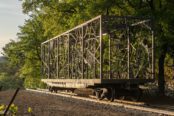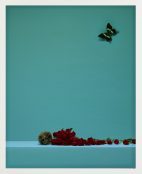A two-woman exhibition entitled The Open Door at LAC (short for Lieu d’Art Contemporain, which translates simply as “place for contemporary art”) in a remote village in the South of France, resembles a trip down memory lane in more sense than one.
Founded in 1991 by Piet Moget, a renowned artist and collector who settled in France after a bohemian life that took him from his native Holland to Spain, Italy and Switzerland before living between France and Sweden, LAC is led by the late painter’s daughter Layla Moget, a respected curator whose love for art is matched only by her love of nature. Arriving a day ahead of the official opening, participating artists are greeted by her excited guard dog, half a dozen cats watch from a safe distance while the horses on the meadows on either side of the building pay little attention.
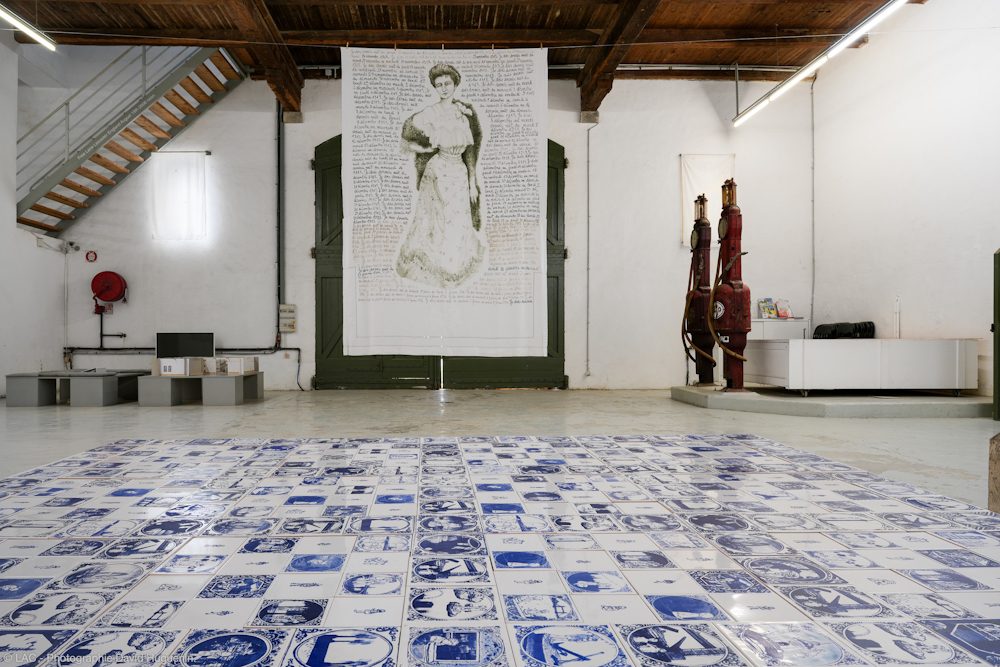
Surrounded by vineyards and situated in a former wine vault, the beautifully restored halls of LAC no longer hold grapes or tools of the wine trade but nowadays provide a unique backdrop for contemporary art. Nothing hints at what lies behind the massive barn doors until guests start arriving from across the region and beyond; the horses now grazing at the far end of their paddocks as cars keep pulling up.
Snippets of English, Dutch and German are mixed in with the mainly French conversations, several visitors regularly making the trip from Barcelona. Having caught up with friends and family members, the focus soon shifts to the works of art on the walls, floors and suspended from high ceilings.

Lead artist and curator Aude Hérail Jäger’s tribute to her late mother lies at the core of the exhibition, a humble display of used matches lined up in bunches across a pristine sheet bearing an elaborately stitched monogram. Most members of the predominantly European audience recognise the symbolism of the embroidered linen, traditionally passed down the maternal line. Some of the guests personally knew the artist’s family and share stories of heritage, inheritance and loss; a journey from a young bride’s opulent dowry to an old woman’s modest treasures, each matchstick representing a meal prepared during the mother’s final years – presented like a prisoner counting down the days.
A wall installation in the next room directly relates to the domestic role generally assigned to women. Taking apart a vintage copy of the French equivalent to ‘Mrs Beeton’s’, Aude Hérail Jäger and Tisna Westerhof collaborated in re-assembling and illustrating the pages, ripping up instructions, performing first aid on generational wounds and redrawing boundaries to metaphorically liberate women from the constraints of the kitchen.
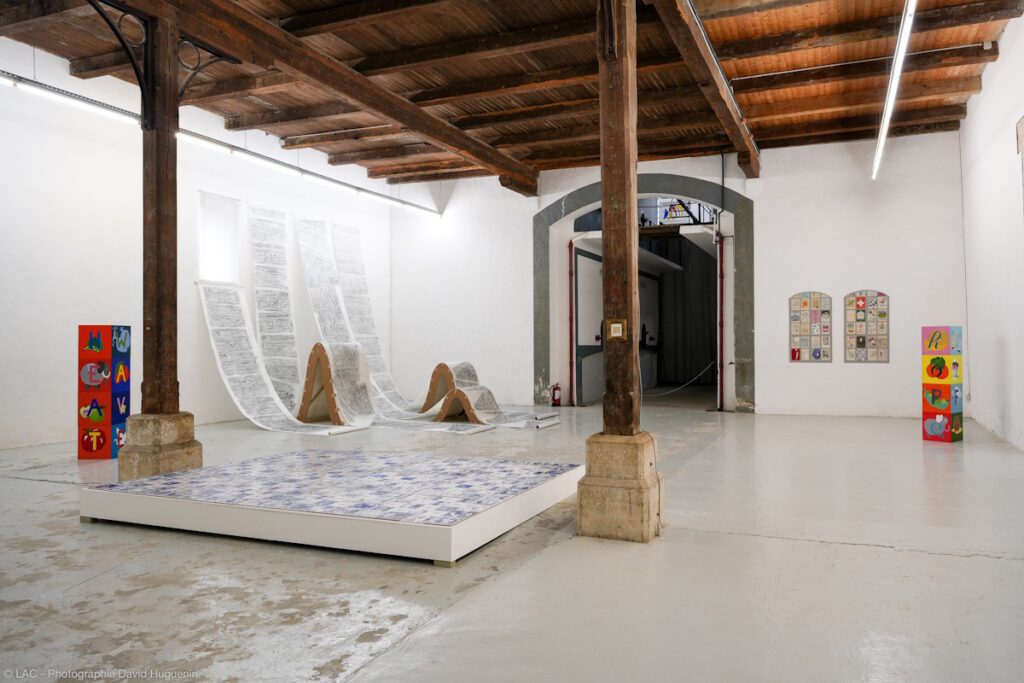
The two artists met in London, their chosen home away from home, and started exchanging thoughts and ideas about belonging and displacement, childhood memories and family ties during the pandemic. The concept for The Open Door started to take shape when Hérail Jäger visited LAC during her first return to France once restrictions were lifted.
Having grown up on a vineyard not far from the gallery, Hérail Jäger ‘s contributions hold a deep resonance with the location itself. Set against the backdrop of her childhood home the artist presents elements of her adult life with examples of graphite rubbings taken at her studio, her London home’s corridor as well as the impressive staircase of 196 Piccadilly, a listed historical building and the first London home of mega-gallery Hauser & Wirth – scrolls of paper cascading down the walls and across the floor, holding the stories of generations.
Having learned about Hérail Jäger’s mother’s fate, curiosity about the identity of the other female figures is raised but not fulfilled. A young woman unable to find rest – one of several works hung from the high ceiling – opposite a portrait of another, this one asleep, drawn onto a vintage pillow case. A nudge towards the airing of dirty laundry in public perhaps, towards the secrets and lies buried in most families’ histories.
These individual yet unidentified figures are protected and defended by a legion of Sentinels who keep watch from the back of the main gallery space. Larger than life and commanding from their elevated position, they combine characteristics of female warriors and tribal costumes, bearing weaponry and gifts. Drawn delicately on tissue paper they float high above, faded histories of strong womanhood. Exotic and familiar in equal measure, they combine symbols of ancient rituals and shared wisdom and are not restricted by cultural or national boundaries.
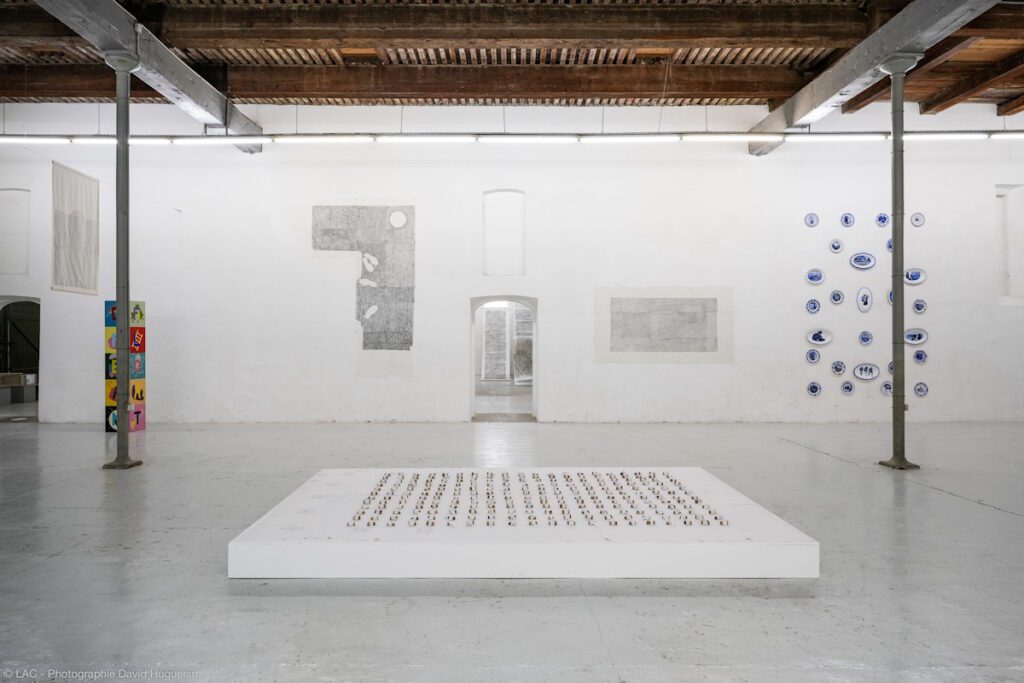
Dotted across both rooms, as if to direct the focus back down to earth, are Hérail Jäger’s oversized alphabet cubes spelling out early learning words like ‘dream’ or ‘hope’. Notions of childhood innocence are picked up in Tisna Westerhof’s Once in a Blue Moon series of idyllic scenes, treasured memories painted in deep blue onto odd shaped, gold rimmed panels.
The distinctive colour is repeated throughout a lot of Westerhof’s work. With an added sense of danger nothing is what it appears at first sight. What from a distance looks like a decorative arrangement of vintage porcelain dishes, on closer inspection turns into a collection of disposable picnic plates depicting scenes of police brutality, civil unrest and protest all too familiar from current news bulletins; nearby motifs of playing children are superimposed onto urban landscapes and polluted rivers, repeated ad infinitum across traditional Delft Blue tiles. Presented close to the floor they mirror Hérail Jäger’s Mother’s Matchsticks, guiding viewers from mourned motherhoods to dystopian childhoods.

Westerhof’s heart shaped Alphabet Hankies, too, provide a more sinister guide to learning the alphabet, ranging from ‘A for acid attack’ to ‘Z for zionism’. Larger stitched works reach even further beyond the artist’s personal visual references and comment on international examples of social and political injustice, from the killing of George Floyd to the Grenfell Tower tragedy.
On closer inspection, the feisty children that greet visitors upon entry may not display examples of happy childhood scenes after all. Using quilting techniques traditionally passed from mother to daughter and frequently embedded with subversive messages, Westerhof combines patches from clothes she wore as a child with newspaper clippings; family snapshots with news agency stills. The girl with inflatable swimming aids and the boy with mushroom clouds on his shirt are possibly not captured in play but in search for safety, the others crossing their arms in defiance of discrimination and persecution.
A project by two women artists whose lives are defined by free movement launched at a woman-run gallery with a truly international history and reputation, The Open Door extends French hospitality, a sense of nostalgia for a simpler life and a reminder of past and present inequalities, to include broader notions of feminism that are not restricted to sexism and overlap with racism and classism.
Caught somewhere between the past and the future, the area’s derelict chateaux and no-longer grand hotels act as reminders of life at a different pace, the never ending rows of grapevines making hard manual labour palpable. This may well be the last decade in which the remnants of a former life can still be truly experienced as the economic focus shifts from traditional winemaking to international tourism. Despite being unmistakably French, Hameau du Lac and nearby Sigean resemble villages and small towns all across Europe, often inhabited by demographics united by a sense of being left behind and a yearning for ‘the good old times’.
The tables and chairs on the forecourt are cleared away now, the leftover wine stored away and just after 9pm the village returned to its former sleepy self.
Those lucky enough to pass through the region before June are treated to a second floor of – predominantly abstract – art above The Open Door with a curated selection of Piet Moget’s own paintings and highlights from his impressive collection interspersed with contemporary works by invited guest artists Patricia Stheeman and Antonello Curcio.
Londoners can look forward to a second iteration of The Open Door at hARTslane Gallery in September. As the exhibition moves from rural France to metropolitan London the line between home and foreign, between a sense of belonging and being other will undoubtedly shift.
A collaborative project adds another dimension through the voices on the fringes of both locations. The artists worked with participants of community workshops in Sigean and London on French and English versions of the Women’s Quilt of Pride, continuing the tradition of a universal craft applied by generations of women across the globe. Individual voices from a broad diversity of community members, ranging from rural art schools to a women’s refuge, come together in this all-embracing expression of unity, dignity and hope.

THE OPEN DOOR by Aude Hérail Jäger and Tisna Westerhof opened on 6 April and runs until 2 June 2024.
L.A.C. (Lieu D’Art Contemporain), 1 Rue de la Berre – Hameau du Lac, 11130 Sigean, France. Gallery Open Times: Thursday – Sunday, 2-6pm
Exhibition shots by D. Huguenin © 2024
instagram.com/lieudartcontemporain
Aude Hérail Jäger
audeherailjager.com
instagram.com/audeherailjagerart
Tisna Westerhof
tisna.com
instagram.com/tisnawesterhof
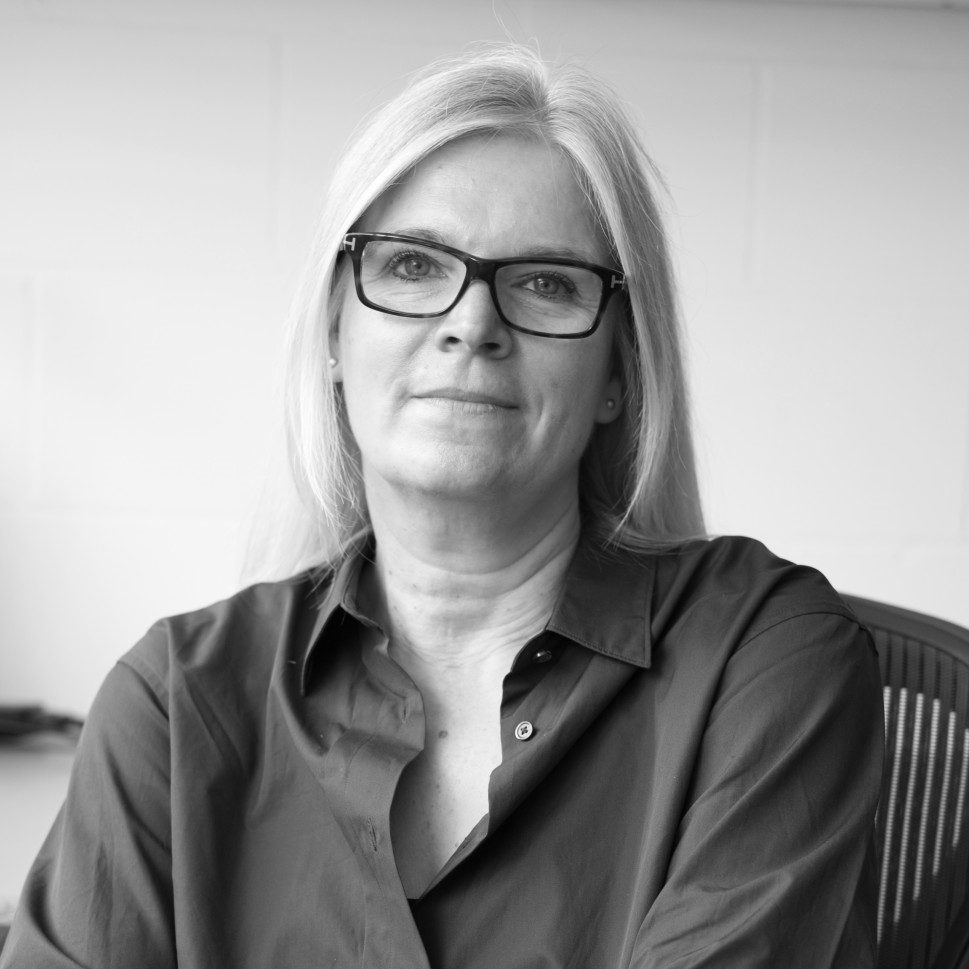
Meike Brunkhorst is a cultural entrepreneur and freelance writer who uses her marketing communications expertise to support independent artists and cultural organisations. Her particular interests lie in international and intersectional collaborations, the amplification of underrepresented voices, and cultural practices that address environmental and ecological concerns.





